February 15. LUXOR "Playing Egyptologists in the Valley of the Kings" It was our final day in Luxor and we were both feeling ready to leave. We were going to leave on the 14th but wanted one final day to explore the Valley of the Kings, now that we had some newly acquired knowledge with which to appreciate the tombs. Crossing the Nile was old hat by now, the taxi drivers laying wait when we got of the boat. We tried with the no thank yous but they persisted. 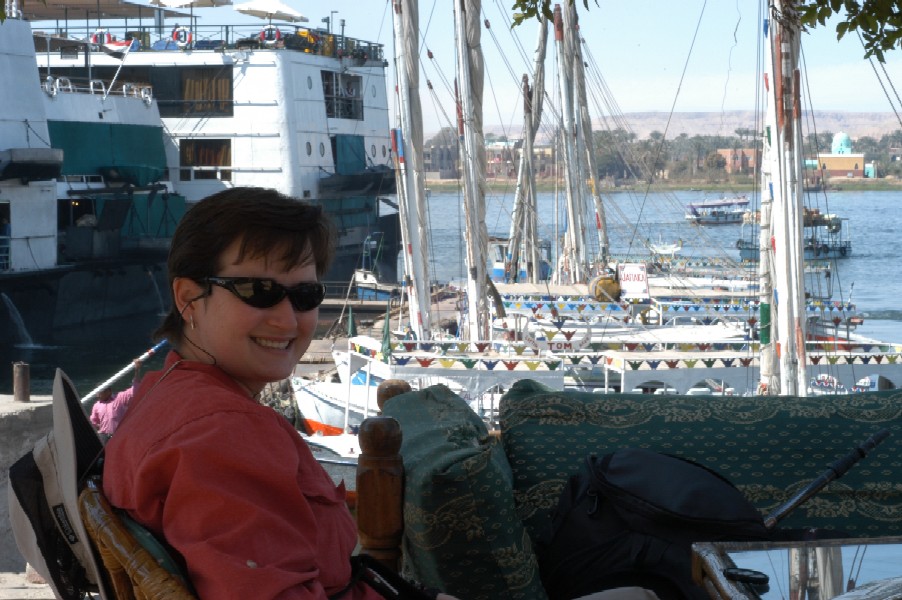 Rob indicated that we preferred the servicees and they were just one pound per person. The taxis wanted 10 pounds. One driver became belligerent and snottily said, "One pound! You don't come back!" The feeling was becoming mutual. But we did prefer the servicees since we always met some interesting people and they were actually more comfortable. To take us all of the way to the Valley of the Kings we paid a bit more than one pound per person but it was still far better than a taxi. We jumped into the taxi to find a group of four women in the back. They smiled when we got in and along the way they started to sing. One led and clapped while the others were the chorus. It was delightful. The service taxi detoured to the temple of Medinet Habu to drop them off and we were sad to see them go. They waived as they got out. Rob indicated that we preferred the servicees and they were just one pound per person. The taxis wanted 10 pounds. One driver became belligerent and snottily said, "One pound! You don't come back!" The feeling was becoming mutual. But we did prefer the servicees since we always met some interesting people and they were actually more comfortable. To take us all of the way to the Valley of the Kings we paid a bit more than one pound per person but it was still far better than a taxi. We jumped into the taxi to find a group of four women in the back. They smiled when we got in and along the way they started to sing. One led and clapped while the others were the chorus. It was delightful. The service taxi detoured to the temple of Medinet Habu to drop them off and we were sad to see them go. They waived as they got out.
Arriving by taxi we entered via the same parking lot as the never ending stream of tour buses. We crossed the parking lot to reach the ticket office ran into a fence that wrapped all along the edge of the parking lot so tourists were forced to walk past the souvenir booths. We didn't want to walk back so Rob jumped the fence and went to the automobile gate to gain entrance. The guards at the gate wouldn't open their gate a foot to let me in. It was unlocked and they only had to swing it open but the guard gave me a big grin and pointed back to the opposite side of the parking lot where the souvenir stands started. He seemed pleased with himself to make me walk all of the way back, but of course he probably would have opened the gate for a bribe. I refused and walked away, mumbling unflattering remarks, and just went back near the ticket booth and jumped the fence.
From the ticket booth it was a long walk up a gradual slope to the site entrance. All of the tour bus weenies had little trains transport them up the slope. It wasn't very hot so we just walked. We passed through the security check. They made people 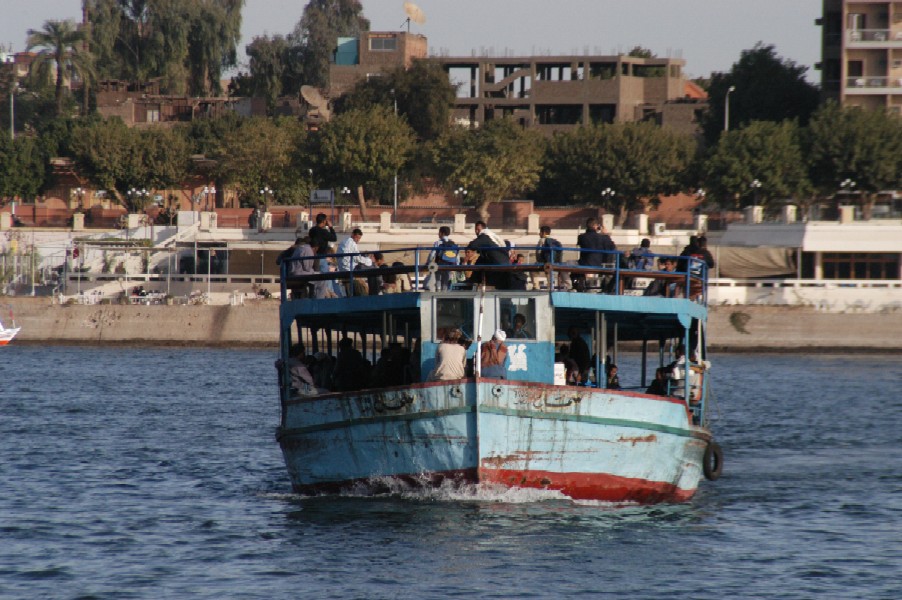 check their video cameras but not their regular cameras, for some reason. One guard asked Rob if he had a bomb and Rob said he left it on the felucca. The guard laughed and gave him a slap on the back. check their video cameras but not their regular cameras, for some reason. One guard asked Rob if he had a bomb and Rob said he left it on the felucca. The guard laughed and gave him a slap on the back.
There were quite a few more tourists in the valley that morning than when we had visited before. Perhaps our guidebook had not been so far off about the morning deluge of tourists. Being crammed into a tomb with a sixty person tour group seemed unavoidable but we still tried to time our visits in between. We passed the tomb of Ramses IX (reigned 1125 - 1107 BC) first and it looked pretty empty so we dipped inside. The solitude was short-lived as a French tour group followed in no time. We were only part way down the first corridor when the descended upon us, chatting away. Fortunately the moved fast and we were only in the second corridor when they started coming back. I was taking a close look at one wall and was directed by one of the tourists to get back on the other side of the corridor. Apparently we weren't following their pre-determined cattle herd method of sightseeing. We had been there first so we just waived him off and continued our slow investigation of the tomb.
As was common in the other tombs that we had seen, the Ramses IX tomb was full of images that referenced the Book of Caverns, the Litany of Re, the Book of the Dead, the Book of Amduat, the Book of the Earth, and the Book of Day and the Book of Night. These all meant little to us on our first visit but now we better understood their significance. The Book of the Caverns was a funerary writing from the 19th Dynasty (1295 - 1188 BC) that divided the underworld into six parts, each showing different "caverns" over which the sun passes on its nighttime journey. The focus of the text is on the god of the underworld, Osir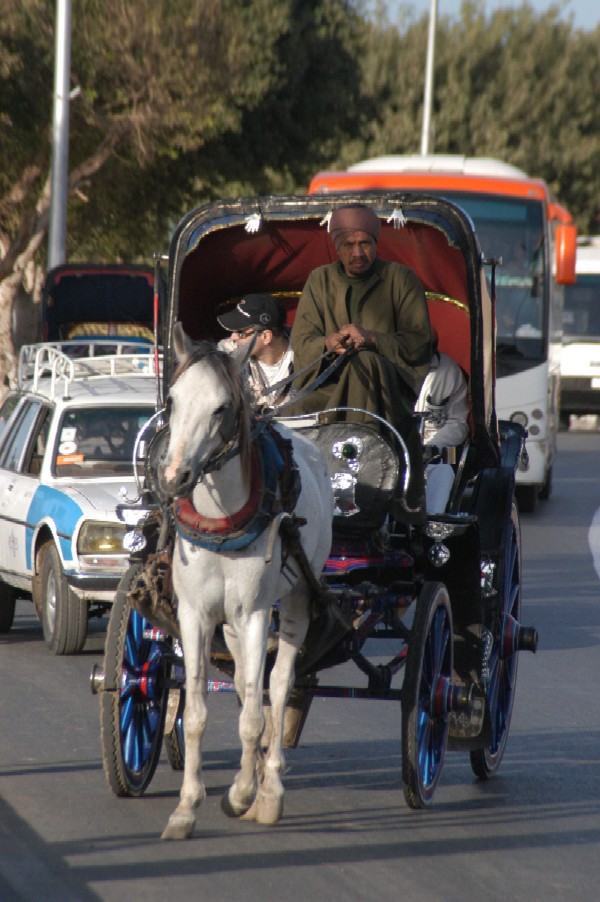 is. The Litany of Re was a funerary writing that originated in the 18th Dynasty (1550 - 1295 BC) and acclaims the sun god Re in seventy-five different forms and praised the pharoah in the form of different gods, particularly as Re. The Book of the Dead was a collection of spells from the Coffin Texts (earlier spell texts) and the Pyramid Texts (the oldest body of religious writings in the world that were meant to ensure the successful passage of the deceased in the after-life). It was used by the pharaohs as well as commoners during the New Kingdom period (1550 - 1076 BC), which encompassed all of the tombs in the valley. Papyrus scrolls with the name of the deceased inserted at certain points were often found in the tombs. The Book of Amduat (That Which Is in the Underworld) was another New Kingdom text that related the twelve divisions of the underworld to the twelve hours of night. The book's mainly focused on the important journey of the sun through the underworld "hours" and its rebirth at dawn. The Book of the Earth was another text that described the sun god Re in the underworld and his going out into the light. The Book of Day and Book of Night also dealt with the regeneration of the sun every morning and assimilated the pharaoh with the sun god Re, with whom he shares rebirth. The sun theme is important in Egyptian tombs! One other book that was not referenced in the Ramses IX tomb but was commonly seen was the Book of Gates, a more complex view of the underworld than the Book of Amduat, the gates referring to the twelve gates that divide the hours of the night. is. The Litany of Re was a funerary writing that originated in the 18th Dynasty (1550 - 1295 BC) and acclaims the sun god Re in seventy-five different forms and praised the pharoah in the form of different gods, particularly as Re. The Book of the Dead was a collection of spells from the Coffin Texts (earlier spell texts) and the Pyramid Texts (the oldest body of religious writings in the world that were meant to ensure the successful passage of the deceased in the after-life). It was used by the pharaohs as well as commoners during the New Kingdom period (1550 - 1076 BC), which encompassed all of the tombs in the valley. Papyrus scrolls with the name of the deceased inserted at certain points were often found in the tombs. The Book of Amduat (That Which Is in the Underworld) was another New Kingdom text that related the twelve divisions of the underworld to the twelve hours of night. The book's mainly focused on the important journey of the sun through the underworld "hours" and its rebirth at dawn. The Book of the Earth was another text that described the sun god Re in the underworld and his going out into the light. The Book of Day and Book of Night also dealt with the regeneration of the sun every morning and assimilated the pharaoh with the sun god Re, with whom he shares rebirth. The sun theme is important in Egyptian tombs! One other book that was not referenced in the Ramses IX tomb but was commonly seen was the Book of Gates, a more complex view of the underworld than the Book of Amduat, the gates referring to the twelve gates that divide the hours of the night.
Combined with the pantheon of Egyptian gods these concepts were a mind boggling amount of information to try and digest while looking a carvings on walls of tombs. The specifics of these various texts were well beyond us but we could relate similar images from tomb to tomb in reference to the same texts and other recurring stories. The most recurring scene was, naturally, the Last Judgment. It showed the pharoah being led to his judgment by Anubis, god of mummification. Anubis weighs his heart against the feather of Maat, the goddess of truth and order, while Thoth, the divine scribe and reckoner of time, recording the verdict. Horus, son of Osiris and Isis and the falcon god of the heavens, then leads the pharoah before Osiris for judgment. Osiris is attended by his sister-wife Isis and his other sister Nephtys.
Walking through the tomb of Ramses IX we passed the Litanies of Re and the Book of Caverns, followed by more Litanies of Re, the Book of the Dead and the Book of 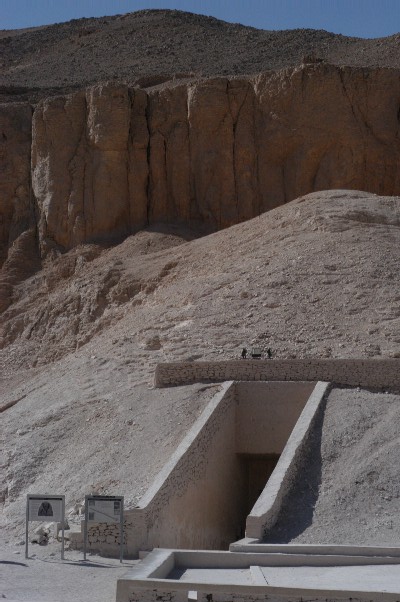 Caverns, all of the hieroglyphics and images carved deeply in sunk-in relief and colored. In the third corridor we encountered the Book of Amduat. The celestial ceiling was painted in cobalt blue background with yellow images of divine boats and processions of deities. A corridors gave was to a small vestibule that was followed by a pillar hall. The final chamber, the burial chamber, was adorned with more from the Book Caverns, Book of Amduat, Book of the Earth, and the Book of Day and Book of Night. One the most memorable images was of the representation of the Book of Day and Book of Night on the ceiling of the burial chamber. The sky goddess Nut is stretched across the ceiling in duplicate forms that sit back to back. She is swallowing up the sun in the evening and we see it pass through her elongated body and come out between her legs as it is reborn in the morning. Her life-giving and regenerating force shine down on the dead pharoah. Caverns, all of the hieroglyphics and images carved deeply in sunk-in relief and colored. In the third corridor we encountered the Book of Amduat. The celestial ceiling was painted in cobalt blue background with yellow images of divine boats and processions of deities. A corridors gave was to a small vestibule that was followed by a pillar hall. The final chamber, the burial chamber, was adorned with more from the Book Caverns, Book of Amduat, Book of the Earth, and the Book of Day and Book of Night. One the most memorable images was of the representation of the Book of Day and Book of Night on the ceiling of the burial chamber. The sky goddess Nut is stretched across the ceiling in duplicate forms that sit back to back. She is swallowing up the sun in the evening and we see it pass through her elongated body and come out between her legs as it is reborn in the morning. Her life-giving and regenerating force shine down on the dead pharoah.
Leaving the Ramses IX tomb we walked towards the back of the valley in search of less popular tombs to explore in peace. We visited Siptah (reigned in 19th Dyansty, 1195 - 1190 BC), a less elaborate tomb but we had it all to ourselves and could explore slowly. It reached 90 meters long and had been open since 1905. From there we continued down the wadi to the tomb of Seti II (reigned in 19th Dynasty, 1201 - 1195 BC), which was quite popular, in spite of what our guidebook had said. We waited for a bit while the crowds had cleared. Most of the groups that went in were of Egyptian women. They were very friendly and a few even tried to chat with us, wishing us a good rip in Egypt. The most interesting characteristic of the Seti II tomb was that it was not completely finished allowing us to see the the early steps of tomb creation where images were just drawn on and corrected by a second person before the sunk-in relief carving was started. The tomb reached 72 meters long. Just down from Seti II was the tomb of Tawsert (reigned in 19th Dynasty, 1190 - 1188 BC) and Sethnakht (reigned in 20th Dynasty, 1188 - 1186). Built by Tawsert but later usurped by Sethnakht it displayed some pretty nice carvings and opened up into a large hall the preceded the burial chamber. It stretched 110 meters long and had been open since antiquity. We tried to walk leisurely through the tomb but one of the attendants kept scurrying along behind us trying to interject incomprehensible comments and, of course, wanted baksheesh for his disruption. It was all becoming too much with the baksheesh business!
We took a break and rested while we regrouped and planned out which tombs to hit last. The women who had shared a taxi with us that morning walked past and waived. When we saw the opportunity we jumped into the tomb of King 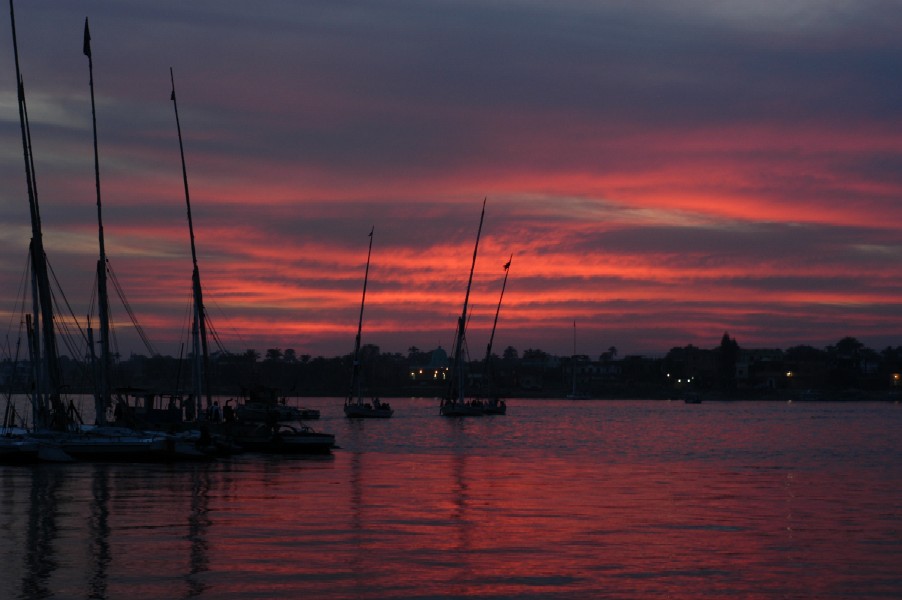 Tutankhamun (reigned in 18th Dynasty, 1333 - 1324 BC). It didn't get great reviews in spite of the high separate priced ticket to get in but since I'd seen the King Tut tour when I was a kid and we'd both heard so much about the discovery of the tomb we went to see it anyway. It was the only tomb where we had to check our cameras. In most of the other tombs taking illegal photos was the way the attendants made their baksheesh money. If you didn't pay you got your camera taken away. The odd thing about them taking our camera's for Tut's tomb was that there was little to take photos of inside. It was built in an awkward U-shape with an initial drop down an unpainted corridor into an unpainted chamber. In fact, the only decorated part of the 40 meter long tomb was the rather small burial chamber. Tut had died young so there hadn't been time to built such an elaborate tomb and the images were just painted, not carved. However, Rob overheard a fellow visitor say that he had seen the tomb not many years earlier and it had been in better condition so it seemed that popularity of the tomb was causing its deterioration. A person can't visit a tomb without leaving some perspiration behind and growing pockmarks on the walls showed the toll it was taking on this tomb. Tutankhamun (reigned in 18th Dynasty, 1333 - 1324 BC). It didn't get great reviews in spite of the high separate priced ticket to get in but since I'd seen the King Tut tour when I was a kid and we'd both heard so much about the discovery of the tomb we went to see it anyway. It was the only tomb where we had to check our cameras. In most of the other tombs taking illegal photos was the way the attendants made their baksheesh money. If you didn't pay you got your camera taken away. The odd thing about them taking our camera's for Tut's tomb was that there was little to take photos of inside. It was built in an awkward U-shape with an initial drop down an unpainted corridor into an unpainted chamber. In fact, the only decorated part of the 40 meter long tomb was the rather small burial chamber. Tut had died young so there hadn't been time to built such an elaborate tomb and the images were just painted, not carved. However, Rob overheard a fellow visitor say that he had seen the tomb not many years earlier and it had been in better condition so it seemed that popularity of the tomb was causing its deterioration. A person can't visit a tomb without leaving some perspiration behind and growing pockmarks on the walls showed the toll it was taking on this tomb.
Getting all tomb-ed out by this time we chose to go back to our favorite tombs one more time with our remaining tickets. Those were Ramses III and Ramses VI. They were both fantastic tombs and with a better understanding of the imagery we enjoyed them just as much the second time around. They were a repeat of much of what we'd seen in Ramses IX but both had better sunk-in reliefs.
Leaving the valley I just didn't have enough left to climb up and over like we had done before. We sucked it up and had to negotiate with a taxi in the parking lot. He tried to really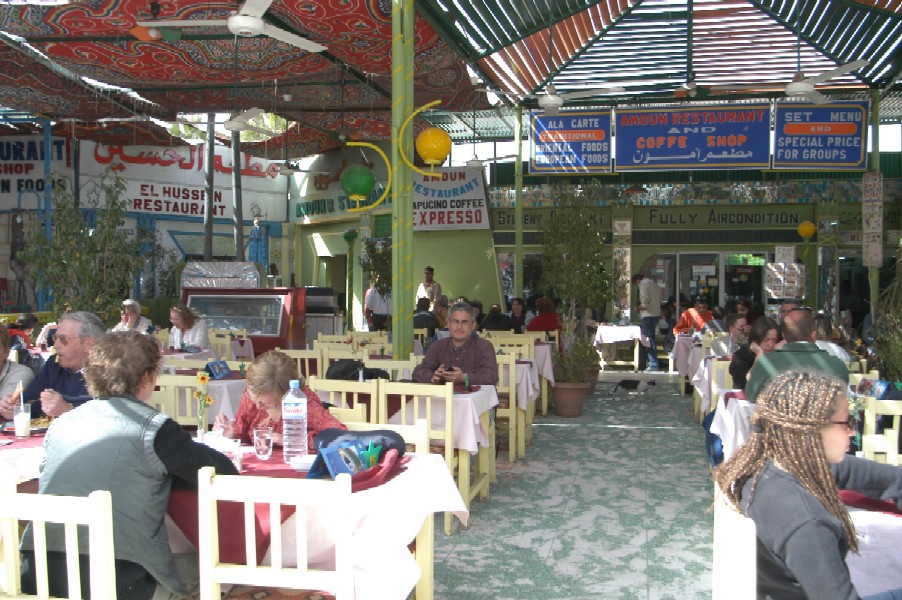 gouge us so we just started to walk whereupon he yelled out a more agreeable rate. This was the dance you had to do repeatedly in Egypt. On the ferry we met a charming older Belgian couple that absolutely loved Egypt and came often. Of course they stayed at the Mövenpick Resort, which might help. That would be the way I'd like to go if I ever came back to Egypt. gouge us so we just started to walk whereupon he yelled out a more agreeable rate. This was the dance you had to do repeatedly in Egypt. On the ferry we met a charming older Belgian couple that absolutely loved Egypt and came often. Of course they stayed at the Mövenpick Resort, which might help. That would be the way I'd like to go if I ever came back to Egypt.
Walking from the waterfront we snapped a photo of a felucca captain as he tried to lure us on a ride. Passing the queue of caleches I snapped a photo of an empty carriage and horse only to have the driver come flying across the street and ask for baksheesh. Enough! We enjoyed one last dinner at Amoun before taking a servicee van back to the hotel, relishing that it was our last day in Luxor! |
GREECE
Athens
Jan 27-Feb 4
EGYPT
Cairo
Feb 4
Feb 5
Feb 6
Feb 7
Aswan
Feb 8
Feb 9
Feb 10
Luxor
Feb 11
Feb 12
Feb 13
Feb 14
Feb 15
Nuweiba
Feb 16-17
JORDAN
Petra
Feb 18
Feb 19
Feb 20
Feb 21
Amman
Feb 22
Feb 23-24
Feb 25
Feb 26
Feb 27
Feb 28
Feb 29-Mar 1
Dead Sea
Mar 2
Mar 3
ISRAEL
Eilat
Mar 4
EGYPT
Cairo
Mar 5
Mar 6
Mar 7
Mar 8
GREECE
Athens
Mar 9
Santorini
Mar 10
Mar 11
Mar 12-13
Crete
Mar 14
Mar 15-16
Mar 17-21
Athens
Mar 22
|

